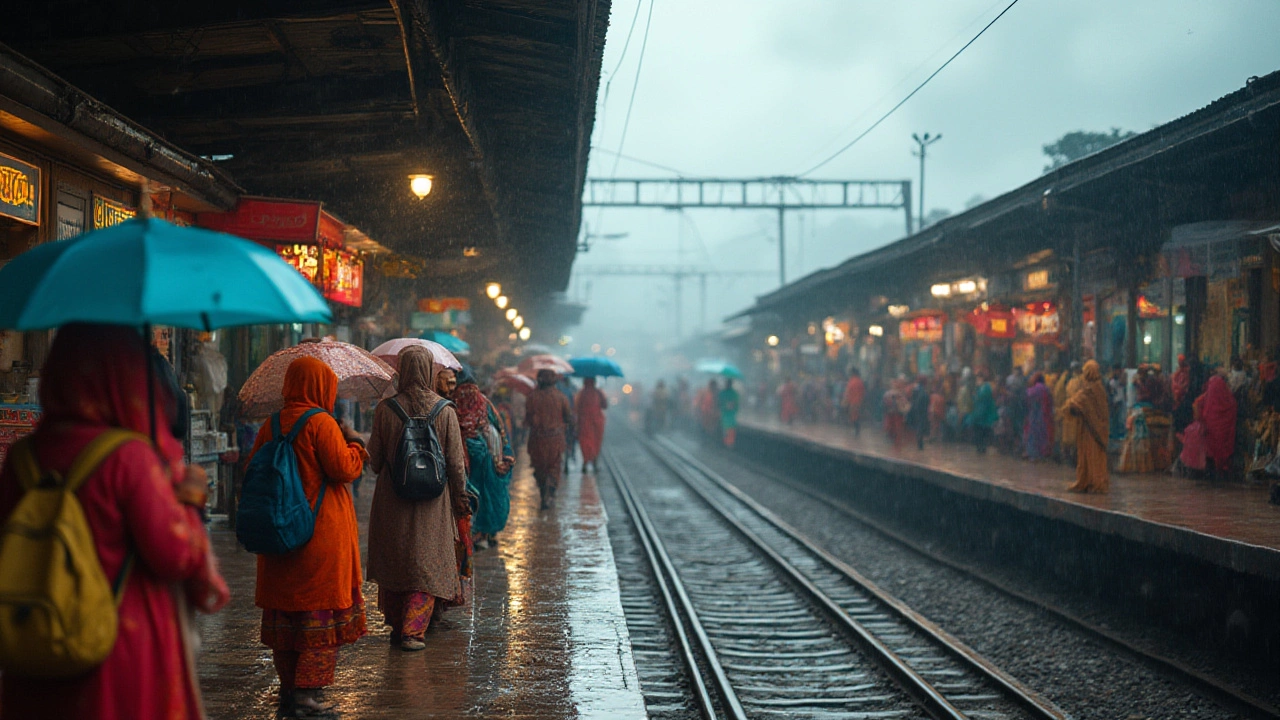Ever scrolled through flight searches and wondered, “Is there ever a truly cheap month to travel to India?” The reality is, prices dance up and down like Holi colors in the air, but if you know when and where to look, big savings are totally on the table. Airfare, hotel rates, even yoga class prices shift depending on the calendar. Miss the crowds, score a room with a view, and stretch your rupees a little farther. So, which month should you circle on your planner for that dream India trip without burning a hole in your wallet? Spoiler: you probably aren’t going to want to pack your sunglasses—unless you love a good thunderstorm.
Why Travel Costs in India Shift So Much by Month
India’s weather forecast changes faster than its street food menus. The country’s climate swings from baking hot summers to drenched monsoons, with delightful in-between periods that send both locals and international tourists flocking to famous sights. Airlines, train companies, hotels—they all know exactly when demand spikes, and they set their prices accordingly. Understanding the seasonal rhythm is your biggest weapon for scoring travel deals.
Peak season in India usually hits from late October all the way through March. Why? Winter brings much-needed relief from the north’s sauna-hot summers and the south’s sticky humidity. Sun seekers from Europe and the U.S., honeymooners, and spiritual adventurers all show up to visit iconic places—think the Taj Mahal shimmering at sunrise or the beaches of Goa packed with festivals. By contrast, the cheap months? Most people shy away from India’s monsoon (June to September) and peak summer (April to June) periods.
But don’t hit snooze yet—there’s more to price trends than just weather. India is known for its endless calendar of events and festivals. Think Diwali, Holi, Pushkar Camel Fair, and big cricket matches. Around these times, city prices (especially hotels and domestic flights) shoot up, but that’s often just for a week or two. Markets, bazaars, even some city taxis jump on the festival bandwagon.
Airline ticket prices are also driven by where you’re flying from—and how far in advance you book. According to data from flight aggregator Skyscanner in 2023, roundtrip flights from the U.S. or UK to Delhi and Mumbai are about 35% cheaper on average during July, August, and early September compared to December and January. Flexibility helps a lot: flying mid-week instead of weekends, and red-eye flights versus morning departures, can drag prices even lower.
Maybe you want a little more than just rock-bottom pricing. Monsoon means fewer tourists, which comes with sweet bonuses: the Taj Mahal without the selfie crowds, last-minute hotel discounts, and zero queue at some of the country’s most famous foodie joints. Fewer school holidays in Europe and the U.S. also mean fewer crowds in India—not just less expensive, but way less hassle. Sure, the heat and rain may scare some off, but you might fall in love with the country’s more mellow pace and the lush, fresh-washed scenery that’s nowhere to be seen during the dry winter.

Cheapest Months to Travel: Monsoon, Summer, and Secret Windows
So, you’re after the best deals. India’s lowest travel prices typically show up from mid-June to September. This is full-on monsoon across most states, and yes, you might get caught in pounding rain that would shock your umbrella. The rains start in Kerala (usually early June), sweep north and east, and don’t really let up until September. Tourist numbers drop off a cliff, and so do airfare and hotel rates.
Let’s talk specifics. Big hotels slash rates by up to 50% in places like Kerala and Goa. You’ll spot beach resorts offering three-for-the-price-of-one nights and Ayurvedic spas running rainy-season massage specials. Train seats, usually impossible to grab in dry season, are suddenly wide open. Same goes for internal India flights: Mumbai to Udaipur, or Delhi to Chennai, can drop to under $25 if you hunt hard enough. In fact, regional airlines like IndiGo and AirAsia India tend to offer last-minute fare sales, especially for routes less likely to interest business travelers that quarter.
Outside coastal areas, some regions turn magical during the wet season. Ladakh, in the far north, sits in the Himalayan rain shadow, so it barely gets any monsoon at all. This is Ladakh’s busiest window—prices here are still higher, but the rest of the country just gets cheaper. Rajasthan, India’s sizzling desert land, is less sweltering during the monsoon months, and desert cities like Jaisalmer and Pushkar are much more pleasant—plus, you’re not elbowing past camera-wielding tour groups.
The overlooked steal? The tail-end of summer—April and May. Yes, the thermometer will challenge you, especially in lowland cities. But hill stations and the southern highlands, like Munnar or Ooty, are at their greenest and surprisingly affordable, since even Indian tourists usually wait for cooler or drier days. You’ll score big on low-season hotel deals. Domestic airlines also roll out flash sales to target last-minute planners as major school holidays haven’t hit yet and many business travelers avoid these months.
Ever heard of shoulder season? That’s late September to mid-October, just as monsoon ends but before foreign tourists return in droves. Many hotels still honor wet-season discounts hoping to lure late-blooming backpackers or digital nomads. Airfares start ticking upwards, so you have to time it right—jump as soon as you spot the transition.
Timing is everything. For example, the world-famous Diwali festival (between mid-October and mid-November) sends prices skyrocketing, especially in northern cities. Book before the holiday surge or wait until it’s done to keep things thrifty.

Travel Tips for Saving Money in India’s Low Seasons
So, you’re eyeing a rainy or scorching cheap ticket—now make those cost-cutting moves count. Pack smarter if you’re traveling in July or August. Bring real rain gear—forget the dollar-shop poncho and opt for a solid waterproof jacket and shoes that can hack sudden puddles. If you plan on temples or hill hiking, a quick-dry towel and an extra phone case won’t hurt.
Booking sites like MakeMyTrip and Yatra launch India-specific hotel deals as soon as summer hits, and Booking.com often features deep discounts on boutique properties in Goa, Kerala, and the southern beaches during the monsoon. Watch out for “pre-monsoon” sales—small properties like homestays or heritage havelis offer bundled meals or free transfers. It pays to send a friendly email asking for extras; Indians love a bargain negotiation, especially when bookings are thin.
Trains? They’re shockingly cheap, but the lowest fares go fast. The IRCTC (Indian Railways) site sometimes opens up last-minute Tatkal quota tickets a day before departure—these can be a blessing if you’re open to early mornings or unglamorous seating. For those overnight hauls, splurge a bit for Air-Conditioned 2-Tier or 3-Tier classes. The price bump is still minimal, especially in low season when even luxury Shatabdi and Rajdhani trains undercut what you’d pay for a basic hostel in Europe.
If you want a beach holiday without the sticker shock, skip Goa in Christmas and February, but go when the monsoon thunderstorms scare others off. Goa turns into a steamy, romantic ghost town, with misty cliffs, wild waves, and empty party shacks. Some local shops close, true. But the seafood is cheap, the locals are relaxed, and guesthouses continually tempt you with discounts—sometimes under $10 a night.
Don’t forget local festivals outside the global headlines. For example, mango season overlaps with the early monsoon—Indian markets stuff themselves with juicy, bargain-priced mangoes you’ll never find back home. In Kerala, the Onam festival brings massive feasts and flower carpets through August and September, and hotel rates haven’t rebounded yet. Meanwhile, you can beat the tourist mobs at Jaipur’s monsoon-specific Teej Festival but grab deep discounts at city palaces and boutique stays.
Internal flights sometimes post flash discounts only in-app, like on SpiceJet or AirAsia India’s platforms. There’s no shame in setting alerts with Google Flights or Skyscanner for your dream route, then pouncing when the dip hits. Digital nomads and backpackers do this all the time, making flexible dates the backbone of their India hacks.
A little goes a long way with currency. Low season means less demand for guides and drivers—they’re open to lower rates. Haggling is expected, as long as you’re polite. And if you’re brave enough for some wet-weather “adventure,” remember: waterfalls like Jog Falls or Athirapally, often bone-dry in winter, are nothing short of dramatic come monsoon.
Long story short? The cheapest time to visit India runs from mid-June to September, but April, May, and late September can offer similar deals if you shop smart. Just research where you’re going—a wet trip to Mumbai is totally different from dry, stunning Ladakh. Play with your dates, gamble on last-minute sales, and don’t be afraid of a little rain or heat. India will reward you with empty temples, quiet beaches, spontaneous festivals, and—occasionally—a hotel pool all to yourself. Yes, on a budget.
